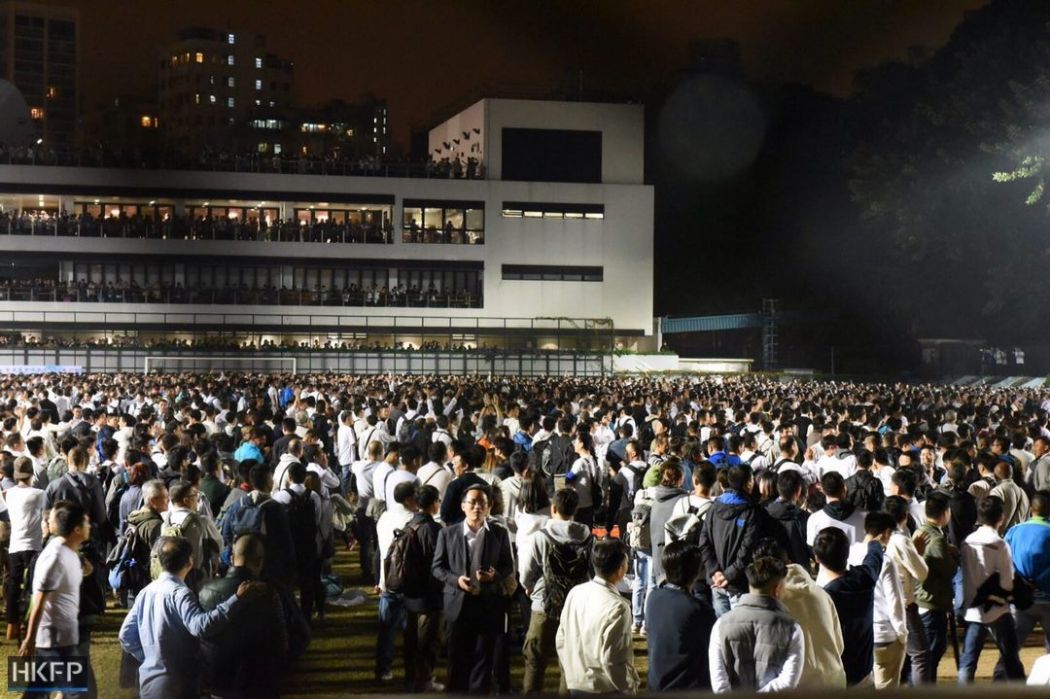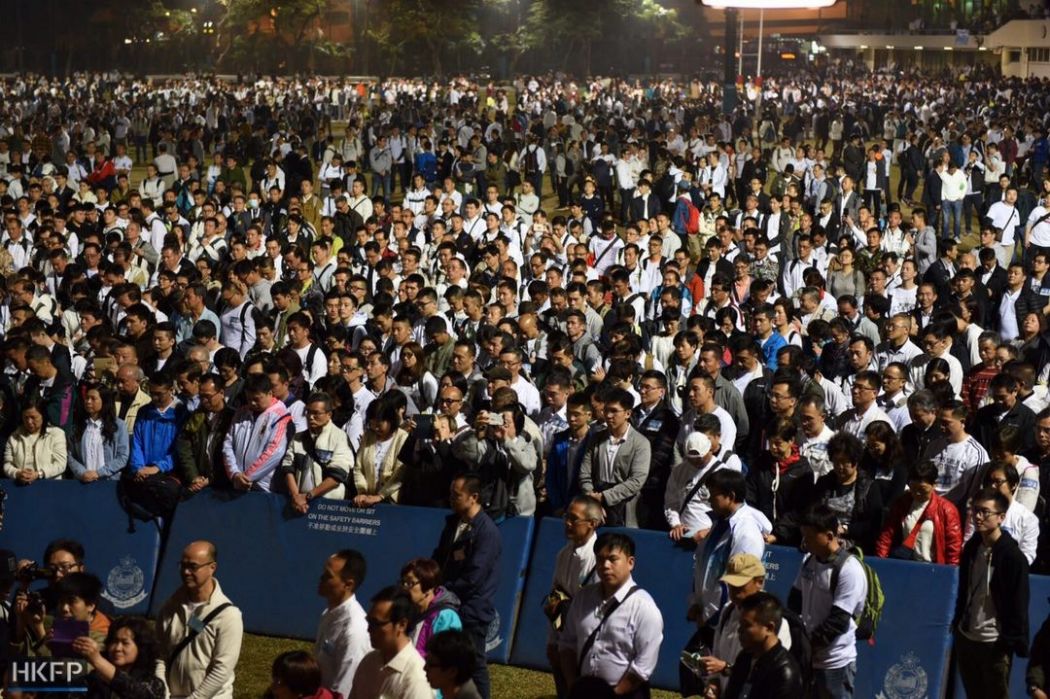The Great Police Rally on February 22 was missing two things usually found on occasions of this kind.
The first was the letter of no objection to a public protest from the police. Several commentators noticed this, though I am not sure it was necessary. The Police Sports and Recreation Club, where the rally was held, is open to policemen and their families. It is also open to former policemen and their families, auxiliary policemen and their families, civilian employees of the police and their families, and even some civil servants with police-related duties… and their families. So long is the list that it once, many years ago, included me. If the members of what is legally, I suppose, a private club, wish to hold a large meeting on a matter of public concern on the premises I am not sure that this needs anyone else’s permission.

On the other hand it seems that the rally was open to the public. The only people specifically excluded were journalists. So perhaps they should have had the letter.
Michael Chugani, in one of his bursts of hypocrisy-hunting, said that anyone who objected to the meeting but did not object to Occupy must be a hypocrite. But surely this must cut both ways. Anyone who objected to Occupy but did not object to the police rally must also be a hypocrite, which suggests that Mr Chugani could get his hypocrisy hunt off to a flying start by looking in the mirror.
The other thing missing from the proceedings on February 22 was the usual report from a police wet blanket that the attendance was much smaller than that claimed by the organisers.
The organisers claimed an attendance of more than 30,000. Well in the absence of an official figure let us see what we can do. The crowd was spread over two pitches, one soccer and one rugby. Both of these are quite small, though. If you look on Google Earth you can see that they are small compared with the public pitch next door, let alone the nearby pitch in the Mong Kok Stadium.
Football pitches vary. But using the tennis courts on the nearby club roof as a yardstick I estimate the two pitches as about 50 yards by 70, which means the space available was altogether about 6,500 square yards.

Looking at the many news pictures of the happy event it is apparent that once you got away from the stage the crowd was quite dispersed, and in distant corners there were no people at all. So I suggest we can reckon a bit over one person per square yard on average, which would give an attendance on the grass of about 8,000.
A lot of faces can be seen at windows in the buildings which overlook the pitches, but these are only four stories high, so it is difficult to believe that there are more than maybe a couple of thousand altogether there. This would give us a total actual attendance of about 10,000, which has about the usual relationship with the number claimed by the organisers, who tend on these occasions to be optimistic.
Of course not all of these people were members of the force. In fact the reporter from the SCMPost, who was apparently not excluded with the other journalists, possibly because he was a foreigner, wrote that most of these present seemed to be retired.
This is not to deny the strength of the feelings expressed at the rally. But we need some perspective. Not all the people there were police people. Those present were not a majority of the force, either. It is reassuring to know that the taste for mass chants of “Fuck your mother” is a minority one. A more modest figure might also have spared us the item in one of the international agencies which reported without comment that organisers claimed 38,000 of Hong Kong’s 22,000 police had attended.

The point of this excursion is not to minimise the levels of dissatisfaction and resentment in police circles, which I understand are quite high, and relate to a number of causes besides the sentences passed on the errant seven officers. The point is that the rally, and some eager editorials in the more leftish media, have been used to give the impression that the sentences concerned have met with widespread disapproval.
I do not think this is the case. Most Hong Kong people seem to think that the convictions were inevitable and the sentences reasonable even if one might, as a soft-hearted layman, have passed less stringent ones oneself. But this sort of deception has real consequences, because people in places like Beijing do not have access to independent media and may confuse coverage in the sort of media which you can access over the boundary with the truth.
Tian Feilong
This brings me to Professor Tian Feilong, the author of an extraordinary piece of work published in Ming Pao and the Post the other week. Professor Tian is a pillar of the Beihang University’s Law School.
Readers who are familiar with my opinion of what passes for the Chinese legal system will understand why I found this choice of career intriguing. So desperate are news websites for pictorial material that we were even treated to a picture of the professor. Let me gratify those feminists who complain that only women in the news get their appearance reported by noting that the professor seems to have a weight problem and a face made for radio. This of course has nothing to do with the merits of his opinions. Socrates, in his day, was also described as fat and ugly.

Professor Tian started with the idea that the sentencing had sparked a public backlash, and ascribed this to the fact that the police miscreants were in jail while the protester they beat up was not. This sent a “strong message that the presiding judge’s moral support lay with the protester.”
He went on to say that “the excessive punishment for the seven officers, at a time when Hong Kong society is in chaos, has prompted a rethink of the value of the rule of law and how it can support the city. Then there are questions about the nationality of the judge, the rationale behind the ruling, impartiality, and possible political motives behind the ruling.”
This is nonsense. Let us start with the “strong message.” The sentences meted out to protesters and errant policemen are not related to each other. They are related to the crimes of which the person concerned has been convicted. For a protester to resist arrest is illegal but not a major crime. For a policeman having arrested a suspect to tie him up, carry him away to a dark corner and beat him up, on the other hand, is a serious affront to law and order, which requires that those in charge of enforcing it should themselves obey the law.

The judge in the policemen’s case had to consider a number of factors in passing sentence. There is the “tariff” which provides an indication of what sentences for particular crimes should be. There are the points made in mitigation by defending counsel. There is the attitude of the accused, who did themselves no favours by seeking to elude responsibility for their actions by trying to discredit the overwhelming evidence against them.
But the sentence imposed on the victim was not and is not relevant. If policemen beat up a suspect who has been guilty of some trivial offence it does not mean that the sentence for them must also be trivial.
Professor Tian has some odd ideas about the law, as you would perhaps expect in view of the rather odd features of the Chinese legal system on which he is no doubt an expert. Social protest movements are extraordinary events, he writes, so “the judge should have differentiated the powers that police are allowed to use in such situations from those normally allowed.”
This is not really a legal argument at all. The judge should follow the law. If the law specifies some police power and not others this is a matter for the legislature, not for judicial inspiration.
It is also totally inconsistent with the facts of the case on which Professor Tian was commenting. We all understand that in major public events the police need and use powers which would not be appropriate in their everyday work. Most people, even most demonstrators, accept that at times when a lot of people are trying to go one way and the police are trying to make them go another there will be some application of force, not all of it in entire accordance with police general orders or the law. In moments of excitement people on both sides of the barricades may lash out.

This, however, has nothing to do with the case of the seven policemen. Their crime was not a bit of over-enthusiasm with the boot or the pepper spray in a moment of public order crisis. Their victim was securely in police custody. Social protest movements are not so extraordinary that they require us to allow policemen to truss people in custody, carry them away to dark corners and kick the crap out of them.
The rule of law requires obedience from policemen as well as protesters. The seven knew they were doing something illegal. That is why they posted a look-out.
Professor Tian now has the wind in his sails, though, and proceeds to complain that judges in Hong Kong are inadequately monitored and supervised. And at this point it becomes clear what his problem is: he knows nothing about the Hong Kong legal system at all, and supposes it to be like the mainland one.
In Hong Kong, unlike the mainland, all trials are public. They are open to the scrutiny of any citizen and the press is admitted as a matter of course.

In Hong Kong, unlike the mainland, the defendant is allowed a lawyer who places his interests first, and does not have to fear that doing so will put him in the same predicament as his client. Said defending lawyer will, if the judge in the case does not come up to scratch, or even if he does, advise a convicted defendant to appeal, whereupon the case will be considered afresh by three other judges. This hearing also will be public. The judgement will be published and will appear on the Judiciary website.
In short Hong Kong has an excellent “oversight mechanism.” It is called publicity. Professor Tian makes the astonishing claim that Hong Kong’s legal system “deviates from what a modern legal system should be like.” I fear he thinks it should be more like China’s. Perish the thought.
